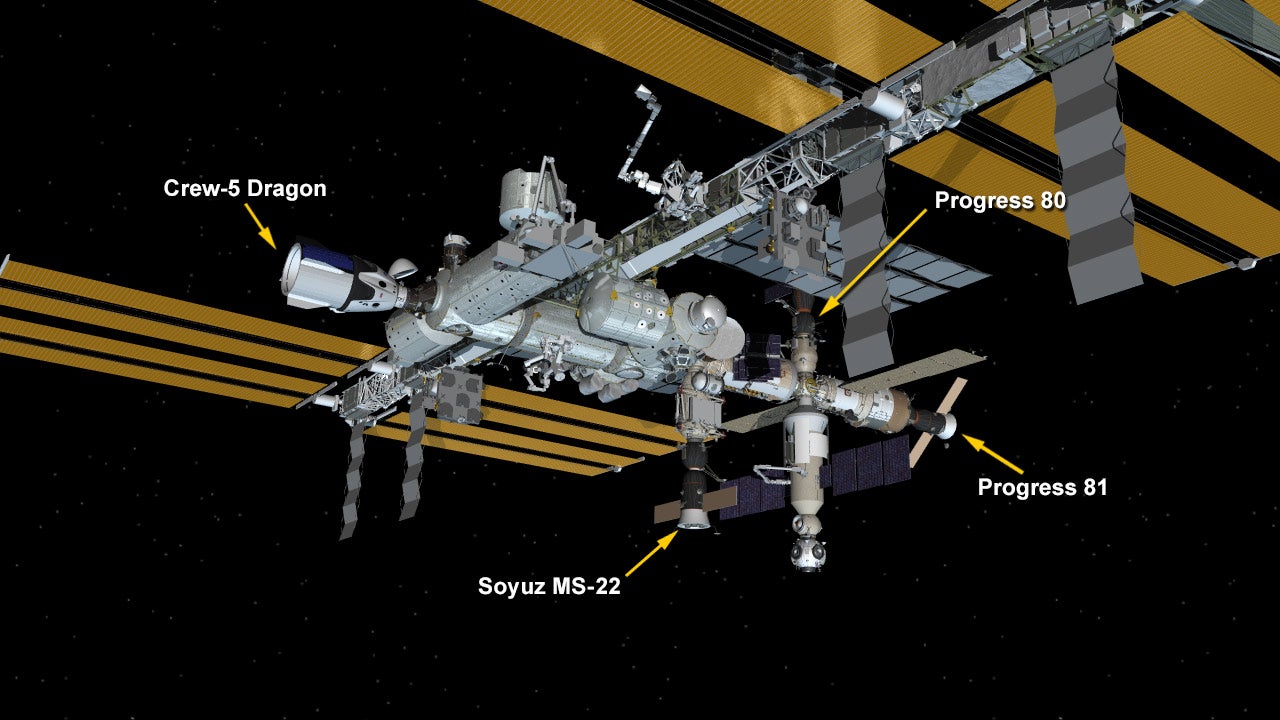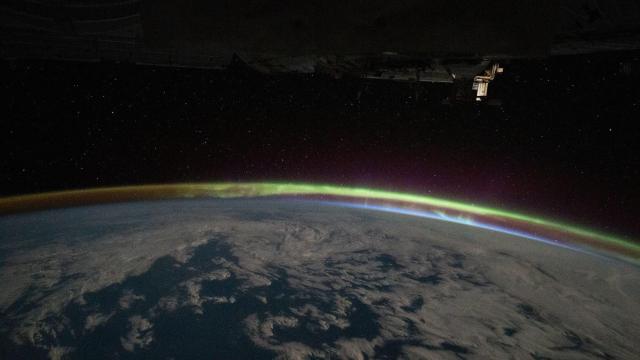All seven members of Expedition 68 are now aboard the International Space Station following the arrival of Crew-5 last week. A cargo mission to replenish supplies is expected next week, prompting a necessary orbital adjustment to receive the Russian space hauler.
The Progress 81 cargo vehicle attached to the Russian Zvezda module fired its thrusters for 10 minutes and 30 seconds on Monday, raising the space station’s orbit and placing it at the correct altitude to receive the Progress 82 resupply ship, according to a NASA blog post. The uncrewed cargo craft is scheduled to blast off from Russia’s Baikonur Cosmodrome on Tuesday, October 25 at 8:00 p.m. ET and dock with Zvezda some 26 hours later.
Four spaceships are currently docked at the space station: Russia’s Progress 80, Progress 81, and Soyuz MS-22, and SpaceX’s Endurance Dragon from the Crew-5 mission. Progress 80, attached to the Poisk mini-research module since February, is not long for this world; the vehicle is being filled with trash and obsolete gear in anticipation of its undocking and intentional disintegration over the South Pacific Ocean next week. Progress 82 will serve as its replacement.

The final four members of Expedition 68 arrived at the orbital outpost on October 6, briefly raising the total ISS population to 11. Crew-5 consists of NASA astronauts Nicole Mann and Josh Cassada, Japan Aerospace Exploration Agency astronaut Koichi Wakata, and Roscosmos cosmonaut Anna Kikina. Crew-4, consisting of NASA astronauts Bob Hines, Kjell Lindgren, and Jessica Watkins, and European Space Agency astronaut Samantha Cristoforetti, returned to Earth on October 14. Prior to leaving, Cristoforetti briefly took command of the ISS, becoming the first European woman to do so.
The now seven-member Expedition 68 crew, in addition to Crew-5, consists of NASA astronaut Frank Rubio and Roscosmos cosmonauts Dmitri Petelin and Sergey Prokopyev. The latter three blasted off atop a Russian Soyuz rocket on September 21 and docked at the Rassvet module later that day. Each member of Expedition 68 will stay aboard the ISS for roughly six months. The crew is already hard at work, performing various maintenance tasks and experiments.

On Monday, Rubio and Mann worked inside the Bigelow Expandable Activity Module, or BEAM, where they organised hardware to be returned on the next SpaceX Dragon mission and gathered air and surface samples for microbial analysis. Kikina spent much of the day training on the computer that controls the newly installed European robotic arm attached to the Nauka module. Meanwhile, Cassada and Wakata took turns with a virtual reality headset to study the effects of microgravity on an astronaut’s ability to reach and grasp objects. Petelin performed water transfer activities, while Prokopyev ran inventory tasks and packed trash inside Progress 80, which is due to leave next week.
Both Rubio and Kikina took part in a seat-swap agreement between NASA and Roscosmos, in which the astronaut reached space via the Soyuz MS-22 mission and the cosmonaut via Space’s Crew-5 flight. The space agencies continue to work together despite tensions caused by Russia’s ongoing invasion of Ukraine. It’s all very awkward, and even a bit inappropriate, but the space partners have little choice but to cooperate given that the ISS cannot function without the participation of both member states.
More: Who’s Going to Regulate All These Private Space Stations?
